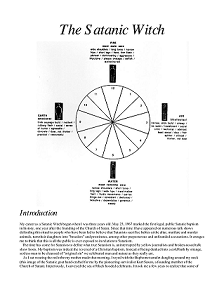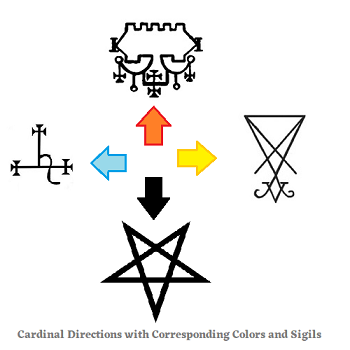LaVey’s Satanic Witch – The Role of Feminism in LaVeyan Satanism
Magic can be used by anyone, male or female, willing to learn the craft. If you are looking for practical advice using real Satanic witchcraft, you will not find it within LaVey’s book

LaVey’s Satanic Witch
What is the typical stereotype of a Satanic Witch? Satanic witchery was first made popular by Anton LaVey, and his book, The Compleat Witch: or What to do When Virtue

Falls, published in 1971. This same book was re-published in 2004 under the title of The Satanic Witch.1 This book was written as a method of instruction to Satanic women and how they could apply their powers of seduction. It is a guide on how to think like a witch, how to dress, how to act and various other advice that LaVey felt characterized the behaviors and natures of women.
LaVey’s method of Satanic witchcraft is a guide to enchantment by using the appearance and personality in such a way that men will fall prey to the witch. This ability to entice men is a measure of personal power. Of course, he offers little practical advice on the esoteric or magical aspects of Satanic witchcraft; his book is a treatise on how he envisioned the Satanic witch to be – as as a fantasy of seduction.
In a published essay titled Satanic Witchery, LaVeyan Satanist Abby Brimstone reviews the concepts of The Satanic Witch, agreeing with LaVey’s stereotypical views of women. Brimstone writes that women live in a “male dominated society”, and “All she really needs is to understand how to maneuver her looks, curves, and intelligence to acquire success and happiness”.2 Brimstone believes that a woman has to use her appearance and feminine wiles to survive and to dominate over men.
Satanic Feminism Today
It surprises me that even to this day some women are willing to fall into the timeless role as the fairer or weaker sex as a method of personal power. This is an imbalanced formula founded upon a timeless stereotype, and based on desire, ego and manipulation. It is not the same as love or self-respect, and the respect that is gained from others, a true personal power more enduring than either beauty or riches.

Blanche Barton, Magistra of the Church of Satan, wrote about her views of women and Satanic witchcraft in her essay, Satanic Feminism. She acknowledged that LaVey tried to promote a kind of feminism that was based on the perceived notions of Christianity, and its “blasphemous philosophical roots”, where women, and lust were considered to be evil.3
In her view the real Satanic witch is compleat because she is the dominant force in her own life, independent, willful and strong. The Satanic witch, according to her, should be “..in constant, intimate spiritual and sexual contact with her strongest Demonic archetype, Satan Himself”.4
Barton’s insight on the matter is interesting, and I like her spirit of Satanic idealism, but LaVey’s agenda seemed to be more about stereotyping women and their role in society, instead of discussing the art of witchcraft. And, the ‘philosophical roots’ of Satanism, as she discusses in her essay, were the subversive ideologies of the Church.
Stereotypical Roles of Women as Witches
LaVey’s definitions of witchcraft allude to his belief that only women could be witches, and they were mysterious and magical with a supernatural ability to seduce men. This is a very shallow perception on the part of LaVey that he promoted because of his desire to objectify women. His categorization of women in The Satanic Witch is based on the Lavey Synthesizer clock, a systematic method of associating body types with temperament.5

LaVey borrowed these ideas from William Sheldon’s system of somatotype,6 a method of determining personality according to a person’s body type and shape. Of course, the theories of Sheldon have been disregarded as false by modern psychologists. Nietzsche also had a belief in three major body types which embodied certain qualities of the personality,7 which some have regarded as a philosophy of racial stereotyping or eugenics.
LaVey had tried to effectively characterize women by their looks in the Satanic Witch. My speculation is that his controlling attitude about women seems to show that he was insecure and perhaps feared the power of the female mind, making him want to control them rather than understand or embrace them.
He portrayed the roles of women as the source of all evil when he created his version of the Black Mass by having a naked woman on the Satanic Altar, an act that glorified the sexuality of women and nothing more. I believe that LaVey’s categorization of women as the source of ‘evil’ perhaps was an attempt to negate the then recent movement of feminist Wiccan witchcraft. It also served to shock and outrage the public and give them something that they wanted at the same time – entertainment. But, magic and witchcraft is not a form of entertainment, especially for those who study and practice it, and use it successfully in every day life.
Magic can be used by anyone willing to learn the craft. If you are looking for practical advice using Satanic witchcraft, you will not find it within LaVey’s book, The Satanic Witch because he did not include practical advice about witchcraft, or spell casting methods.
I do not believe that Satanic Witchcraft is only for women, or that sexuality is the only and greatest power that a woman is capable of achieving. It certainly plays a role in seduction, but real Witchcraft is a method of magic that anyone can use. It’s origins are from many sources and the techniques of spell making are an ancient craft, the craft of the wise.
References:
1. Anton LaVey. 1971. The Compleat Witch: or What to do When Virtue Falls. (Amazon) Dodd, Mead and Company. [accessed 7/9/2017]
2. Abby Brimstone. 2003. Satanic Witchery. The Trident, Issue 10. (Archive available at http://archive.li/6Uskz) [accessed 7/9/2017]
3. Blanche Barton. 1997. The Black Flame, Volume 6, #1 & #2. Satanic Feminism. from: http://www.churchofsatan.com/Pages/Satfem.html [accessed 7/9/2017]
4. ibid.
5. Anton LaVey, fwd by Zeena LaVey. 1989. The Satanic Witch. (Amazon) Feral House Publishing. [accessed 7/9/2017]
6. Somatotypes. Wikipedia. Accessed 12/16/08, from: http://en.wikipedia.org/wiki/Somatotype [accessed 7/9/2017]
7. Friedrich Nietzsche, H.L. Mencken. The Antichrist. (Amazon) 1999. See Sharp Press. [accessed 7/9/2017]



